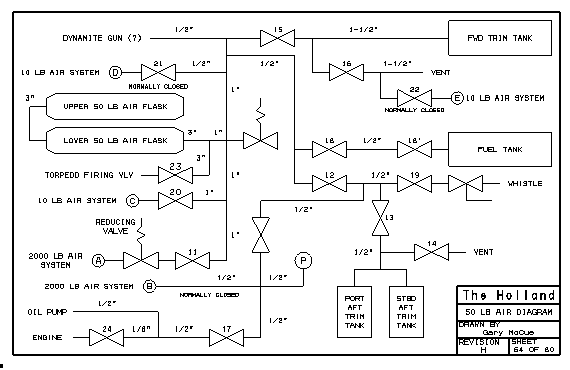

The 50 psi subsystem included the following equipment:
Three 50 psi air flasks
There were three 50 psi air flasks. One flask with a capacity of 4-1/2 cubic feet supplied the machinery, and two flasks linked by a 3 inch line with a capacity of 5-1/2 cubic feet for the expulsion of torpedoes.
This was an automatic valve with two diaphrams that permited filling the 50 psi air flasks with air from the 2000 psi system and/or the air compressor.
| Valve 11 | served to isolate the 50 psi system from the 2000 psi reducing valve. |
| Valve 12 | served to isolate the midbody and aft systems (whistle, aft trim tanks, hydraulic pump and engine). |
| Valve 13 | was used to blow out the aft trimming tanks. |
| Valve 14 | served to vent the aft trimming tanks into the submarine. |
| Valve 15 | was used to blow out the forward trimming tank. |
| Valve 16 | served to vent the forward trimming tank into the submarine. |
| Valve 17 | served to isolate the hydraulic oil pump* and the gas engine intake |
| Valve 18 | was used to blow out the gasoline tank. |
| Valve 19 | was used to operate the ship's whistle. |
| Valve 20 | controlled the supply of air to the reducing valve serving the 10 psi system. |
| Valve 21 | provided a means of bypassing the reducing valve and supplying 50 psi air to the 10 psi system. |
| Valve 22 | provided a means of bypassing the reducing valve and supplying 50 psi air to the 10 psi system. |
| Valve 23 | supplied air to the torpedo firing valve. (50 psi air was used to eject the torpedo). |
| Valve 24 | supplied the gas engine with compressed air. |
In addition to using 3 inch pipe between the forward flasks, 1-1/2 inch piping was used for the forward trim tank blow and vent, and 1 inch piping was used on the main fore and aft run. All other piping in the 50 psi system was 1/2 inch nominal diameter.
* The oil pump was a two cylinder double acting device used to power the steering and diving gear hydraulic rams. The spent air was vented into the submarine causing the internal air pressure to increase. When the pressure increased to a predetermined level, a poppet type valve located just aft of the whistle would open, releasing the air into the sea and equalizing the pressure.
ÓCopyright 1999,2000,2001,2002 Gary McCue